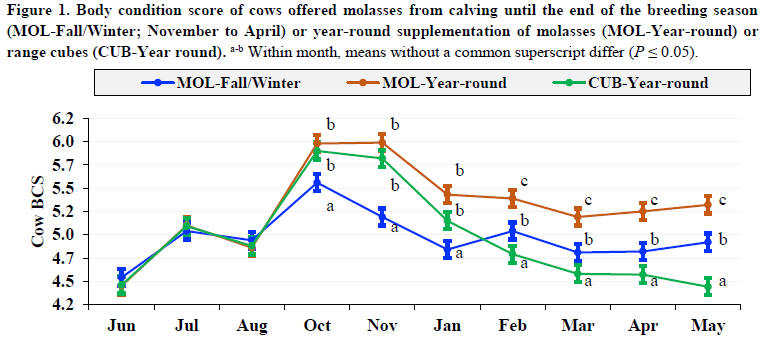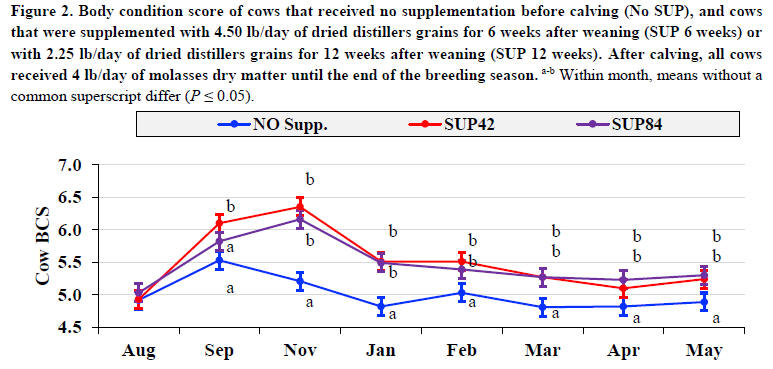- Return to Article Of The Month index
Nutrition for Pregnant Beef Cows
February, 2019
Dr. Philipe
Moriel,
UF/IFAS Range Cattle Research & Ecuation Center, Ona
Body condition score (BCS) at calving is the most important factor that
influences overall pregnancy rate and calving distribution of beef cows.
Also, poor nutrition during gestation can alter fetal organ formation and
decrease offspring’s future performance (fetal-programming). In 2016, our
group obtained funds from The Florida
Beef Enhancement Board to evaluate different supplementation strategies
for pregnant beef females and its impacts on performance of cows and calves.
In this article, we will provide a draft summary of the results currently
available for both studies.
STUDY
#1 – Does year-round supplementation of cows pay off?
We believed that year-round supplementation of molasses or range cubes
would increase cow BCS throughout gestation and at calving. Also, year-round
supplementation of molasses and range cubes would improve calf development
during pregnancy, and then, calf growth after birth. In June 2017, mature
Brangus cows were allocated to bahiagrass pastures. Treatments consisted of
control cows supplemented with molasses from calving until end of breeding
season (November to April;
MOL-Fall/Winter), or cows receiving year-round supplementation of
molasses (MOL-Year-round) or
range cubes (CUB-Year-round).
The total annual amount of supplement was similar among all treatments (600
lb/cow; Table 1). Trace mineral/vitamin supplementation is being provided
during the entire year in a loose meal form for MOL-Fall/Winter cows, or
mixed into the molasses or range cubes for cows assigned to year-round
supplementation (MOL-Year-round and CUB-Year-round cows).

As expected, molasses and range cubes supplementation increased cow BCS
at calving (November) compared to cows receiving no supplementation (Figure
1). Although cows assigned to year-round supplementation of molasses and
range cubes lost more BCS from calving until the start of the breeding
season (Table 2), both treatments maintained greater BCS at the start of
breeding season compared to control cow (MOL-Fall/Winter cows). However, no
differences were detected for pregnancy rates among treatments (Table 2),
which was unexpected, but can be explained by the fact that the control cows
(MOL-Fall/Winter) calved in an acceptable BCS (despite the lack of
supplementation before calving) and had minimal BCS loss after calving.
It is important to
highlight that our group has only 1 year of data collection up to this
moment. We are repeating this study for a second year to confirm such
results.
Despite the greater nutritional status of cows during late gestation
(indicated by the greater BCS at calving compared to MOL-Fall/Winter cows),
calf body weight at birth and weaning did not differ among treatments.


STUDY 2 –
Supplementing cows during
late-gestation
This study:
(1) evaluated if dry distillers
grains (DDG) supplementation of cows during the entire late-gestation
(2.25 lb/day for 12 weeks = 189 lb
per cow; August to November) would increase cow reproductive success and
calf performance after birth, and
(2) investigated if concentrating cow DDG supplementation during the
period of lowest nutrient demand (first 6 weeks after weaning) would be more
cost-effective than cows supplemented during the entire late-gestation.
First, we believed that cows supplemented before calving, regardless of
length of supplementation, would have greater reproductive performance than
non-supplemented cows. Second, we believed that supplementing
4.50 lb/day for 6 weeks after
weaning would reduce feed costs while maintaining cow reproduction
success, but it would not cause fetal-programming effects (due to the
shorter supplementation period). In contrast, supplementing
2.25 lb/day for 12 weeks would
increase feed costs (due to increased labor), but enhance calf growth after
birth.
The main question is: is the best
nutritional management for the cows also going to result in the best impact
on future offspring performance?
At the time of calving (November),
cows that received supplementation for 6 weeks or 12 weeks had similar BCS
(Figure 2). This response indicates that a 6-week period of supplementation
was more cost effective than a 12-week supplementation period, because cows
supplemented for 6 weeks achieved the same BCS at calving and had half of
the feeding labor costs compared to cows supplemented for 12 weeks. Also,
cows supplemented for 6 weeks or 12 weeks had greater BCS at the time of
calving AND at start of the breeding season compared to control cows
that did not receive supplementation before calving. However, no differences
were observed for cow reproductive performance during the 2018 breeding
season. As observed in STUDY 1, control cows (NoSUP) calved in an acceptable
BCS and had minimal BCS loss after calving, which likely benefited their
subsequent reproductive performance. This study is being repeated for an
additional year to confirm such results.
Contrary to STUDY 1 described above,
we observed differences in calf pre-weaning performance in STUDY 2. Calves
born from cows that received supplementation for longer periods (SUP 12
weeks) were 26 lb heavier at weaning compared to remaining treatments. These
results (if confirmed after the second year of data collection)
indicates that in terms of calf performance, longer periods of
supplementation (with smaller daily supplement amount) was required to
increase calf weaning weights, and that decreasing the length of cow
supplementation period prevented increments on calf weaning weights. If we
assume that labor costs in this study was approximately $5 per cow for those
assigned to 12 weeks of supplementation, then labor costs for cows assigned
to 6 weeks of supplementation would be $2.50 per cow. A savings of $2.50
only. However, the additional calf weaning weights of 26 lb would generate
$39 (calf additional value = 26 lb x $1.50 per pound). This additional calf
weaning was not observed in cows supplemented for only 6 weeks. Hence, by
trying to save $2.50 in cow labor costs, we would not harvest $39 of
additional calf weaning value. The
major conclusion for this study provides evidence that the best nutritional
management for cows sometimes does not result in the best outcome to
offspring performance. As mentioned before, this study is being
replicated once more to confirm these results.


Online
training - Body Condition Scoring (BCS):
Our group, in collaboration with the South Florida Beef and Forage Program,
developed an online BCS training tool to educate and improve the accuracy of
BCS among stakeholders. It is
unique, free and can be taken multiple times!
To access this training, please
visit:
rcrec-ona.ifas.ufl.edu

